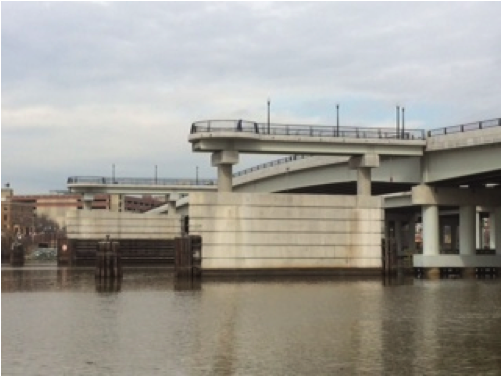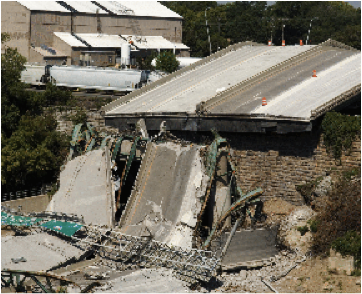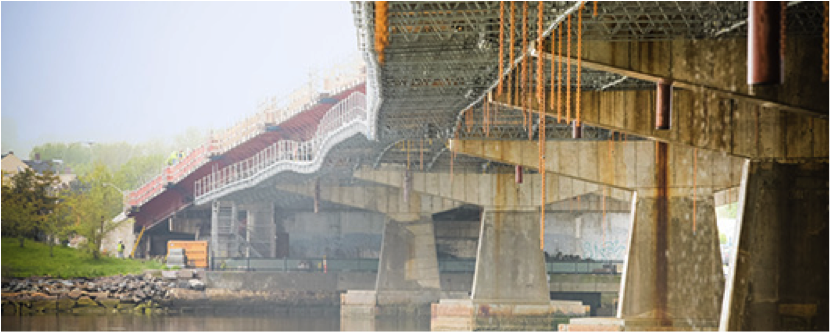On June 27th in Washington D.C., a new report was released that outlines innovative new ways that the federal government, industry and other stakeholders can work together to solve the crisis of the failing state of U.S. infrastructure. Entitled “Making The Grade,” the six point plan is the result of experts from 45 different organizations, including corporations, professional organizations, think tanks, financial advisors and academic institutions.
The report’s name is intended as a rallying cry in response to last year’s quadrennial report card by the American Society of Civil Engineers (ASCE), which gave America’s overall infrastructure a D+ grade. Several of the report’s contributors continued the rallying cry in a #FlashBlog event last week. Following is a summary:
Why we need a national infrastructure bank
By Leanne Tobias, GreenBiz.com
Building on the ASCE findings, Autodesk, in association with CGLA Infrastructure, led 45 corporations, think tanks, academic institutions and others in developing a newly released study, “Making the Grade” (PDF), on solving our national infrastructure crisis. The report, on which I served as an expert advisor, lays out a six-point plan for regaining America’s infrastructure leadership – among them establishing a national infrastructure bank.
Infrastructure investment is good business that would boost America’s economy. An estimated $150 billion annual infrastructure program would create 1.8 million jobs and add $300 billion to $400 billion to our GDP, according to economist Laura Tyson McKinsey also notes that $1 in infrastructure spending typically yields an estimated $1.59 in additional economic activity, while infrastructure upgrades ultimately could unlock $1 trillion in productivity savings worldwide.
I believe the key issue in returning America to infrastructure leadership is mustering the political will to establish and finance a national infrastructure bank. While additional infrastructure spending long has been supported by a wide coalition that extends from the U.S. Chamber of Commerce to the AFL-CIO, fear of engaging in the necessary spending has sapped political interest. In order to raise the required financing, the “Making the Grade” report supports the sale of bonds to the public and corporations, much like the war bonds that helped to produce an American victory in World War II.
See more at: http://www.greenbiz.com/blog/2014/07/21/why-we-need-national-infrastructure-bank
…
Is Our Infrastructure Making the Grade? We Know the Answer
By Clark Barrineau, American Society of Civil Engineers (ASCE)
A few weeks ago, a new report from CG/LA Infrastructure and Autodesk offered a six-point plan to address the dismal D+ grade from our 2013 Report Card for America’s Infrastructure. As Rep. John Delaney (D-MD) put it, “there are real economic costs associated with our infrastructure gridlock. This is a domestic emergency.” Throughout the new report, we see many parallels between the six recommendations and both the Vision and Key Solutions offered in the ASCE Report Card: leadership at all levels of government, promoting sustainability and resilience, and making sure that we have comprehensive plans in place to make the best decisions on how to spend our limited dollars.
Perhaps the most critical point between the two reports is that we need to view all of the recommendations through the lens of an interconnected infrastructure system. It’s not about choosing a sector to prioritize first – whether that be roads, water, or our energy grid. Unfortunately, our maze of agencies and jurisdictions that deal with infrastructure policy are most often set up that way.
Read more at: http://blogs.asce.org/is-our-infrastructure-making-the-grade-we-know-the-answer/
…
Extreme Makeover: Infrastructure Edition
by Joanna Kramer, 2014 Summer Intern, 11th Street Bridge Park
organized around the central question raised by the recently published Making the Grade report: How can the U.S. once again become a leader in the field of infrastructure?
 At 11th Street Bridge Park, this is a question we are also considering. All across the country, cities are being confronted with aged-out infrastructure—bridges, roads, and railroad trestles of past eras. What should we do with them to provide a public benefit? What can we do with them to engage the public with our built past?
At 11th Street Bridge Park, this is a question we are also considering. All across the country, cities are being confronted with aged-out infrastructure—bridges, roads, and railroad trestles of past eras. What should we do with them to provide a public benefit? What can we do with them to engage the public with our built past?
We don’t see the old 11th Street Bridge as a piece of infrastructure that is slated for the wrecking ball; rather, we see it as the future site of DC’s first elevated public park, an iconic landmark in our city’s landscape that will connect residents on either side of the Anacostia River and enhance the area’s economic, physical, cultural and environmental health.
To regain U.S. competitiveness in infrastructure, though, we need to take more steps as a nation—not just as individual cities—to encourage the adaptive reuse of outdated infrastructure, and so we offer our deep gratitude to the terrific teams at CG/LA and Autodesk for working tirelessly to place infrastructure leadership on the national agenda.
Read more at: http://www.bridgepark.org/blog/extreme-makeover-infrastructure-edition
…
Making the Grade: Views from the Floor
Contributors: Lidia Berger, Michael Walsh, Dewberry
In 2013, experts from 45 companies representing the scope of the U.S. infrastructure industry, along with their governmental, financial, and academic counterparts, gathered in New York City for a roundtable discussion on how to fix the infrastructure our grandparents built. As custodians of these decrepit systems, this roundtable represented a nationwide consensus to hand off a more connected, resilient, and sustainable infrastructure to our own grandchildren.
One year later, those same industry leaders have focused on a six-point plan of action and have gathered again to discuss financing it in an intelligent and realistic way. Being on the floor of the first and second conferences, we overheard firsthand the concerns of those who created the original six-point plan. Among them:
- Roadway Connections Only Matter When Traffic Crawls
- Grids are Presumed Resilient Until Ancient Substations Short
- Stormwater Drains are Invisible Until Storms Turn Driveways into Lagoons
We’ve Done it Before, We Can Do it Again
The failing state of U.S. infrastructure is a real and present danger, but we Americans are an optimistic people. We built the transcontinental railroad across the plains during the civil war; the Panama Canal after the French failed; the Erie Canal with public/private funds; the Eisenhower Highway System during the Cold War; and we built a veritable fortress of risk reduction around New Orleans in just six years.
The key to fixing this national issue is to create an urgency of now. As it should be, our political leaders are very good at creating urgency, empathy, and innovation during times of great stress. We need to harness that power during more normal times when catastrophic disasters aren’t present. That power can come from the vision provided by Making the Grade.
Read more at: http://www.dewberry.com/news/blog/14-07-22/Making_the_Grade_Views_from_the_Floor
…
In the Fold
Autodesk
The ASCE estimates that US$3.6 trillion must be invested by 2020 to make critically needed upgrades and expansions of national infrastructure — and avoid trillions of dollars in lost business sales, exports, disposable income and GDP.
 While much has been written and discussed about the problem, Making the Grade provides substantive recommendations and workable solutions to help meet today’s and tomorrow’s infrastructure needs.
While much has been written and discussed about the problem, Making the Grade provides substantive recommendations and workable solutions to help meet today’s and tomorrow’s infrastructure needs.
The report’s six-point recommendations include: 1) Making infrastructure a cabinet-level priority; 2) Forming U.S. infrastructure regions; 3) Establishing a national infrastructure bank; 4) Selling “opportunity” bonds; 5) Creating a national infrastructure index and 6) Engaging the American people to build support for the importance of infrastructure policy.
Read more at: http://inthefold.autodesk.com/in_the_fold/2014/06/6-ways-to-fix-americas-failing-infrastructure.html#sthash.7pLErTC7.dpuf
Tags: 11th Street Bridge Park, American Society of Civil Engineers, ASCE, Autodesk, Dewberry, Flash Blog, GreenBiz.com, Making the Grade







 RSS Feed
RSS Feed